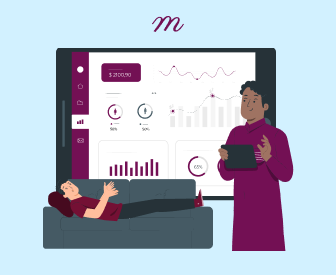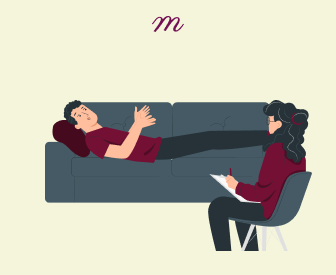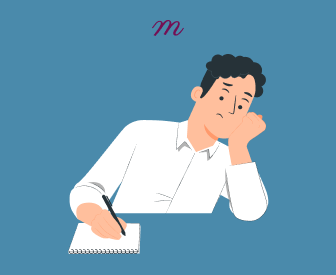Have your progress notes written for you automatically
The connection built in the first therapy session can shape the entire therapeutic journey. Research consistently shows that the quality of the initial interaction significantly impacts treatment outcomes. It’s a delicate blend of professional skill and raw human empathy—where every word, every pause, and every shift in body language plays a role.
There’s a moment—right before the first therapy session begins—when it feels like you’re holding your breath underwater. I’ve experienced it from both sides: first as a nervous client, and later as a new therapist unsure of how to break the ice. Now, after years in practice, I’ve come to realize just how crucial those first few minutes are.
In this article, I’ll walk you through how I approach first sessions, what I’ve learned from real client experiences, and the practical strategies that can help therapists create a strong foundation from the very beginning.
Preparing for Session One: Setting the Right Foundation
Pre-session preparation is more than just making sure your notepad is straight and the tissues are within reach. This is about getting your entire emotional ecosystem ready for another human’s raw, unfiltered truth.
My pre-session ritual is part meditation, part professional warm-up, and part internal pep talk. Some days, it looks like a quick mindfulness exercise. Other days, it’s dancing in my office to shake off whatever emotional residue I’m carrying from previous sessions or my own life.
Here’s my non-negotiable pre-session checklist:
1. Emotional Detox
- 5-minute meditation or breath work to clear my mental clutter
- Shake out physical tension (literally—I’ll do some weird arm wiggling or shoulder rolls)
- Set an intention: “I’m here to listen, not to fix”
2. Physical Space Preparation
- Check lighting (soft, not interrogation-room bright)
- Adjust chair positioning to feel inviting but not invasive
- Have water available
- Ensure room temperature feels comfortable
- Quick scan: Does this space feel welcoming or sterile?
3. Intake Form Deep Dive
- Read between the lines
- Note potential emotional triggers or sensitive areas
- Prepare open-ended questions that show genuine curiosity
- Flag any immediate safety concerns
4. Personal Energy Check
- Am I fully present?
- Have I processed my own stuff so it won’t leak into the session?
- What personal biases might I need to check?
5. Practical Prep
- Silence phone notifications
- Have notepad ready
- Keep session notes nearby but not visibly dominating the space.
The goal isn’t perfection. It’s intention. It’s saying to myself and the incoming client: “I’m ready. I’m here. Your story matters.”
One tool that has made my first therapy sessions much easier is Mentalyc. Taking notes while trying to stay fully present can be a real challenge, especially during that critical first meeting. Mentalyc helps by streamlining the documentation process with AI-generated progress notes, so I can focus more on building connection and less on scrambling to write everything down. It’s like having a silent assistant that helps me capture what matters—without pulling me out of the moment.
The First Therapy Session: Building Trust, Setting the Tone, and Creating a Safe Space
The First Moments
The first 30 seconds can define your relationship, and I’ve certainly been wrong more times than I’d like to admit. I remember once trying to be clever with an initial question and ending up sounding like I was judging the client.
Now, I’ve got my routine down:
- When a new client walks in, I make sure my smile is real—the kind that actually reaches my eyes. Not that fake, plastic smile, but the kind that says, “I’m human, and I’m here with you.”
- Eye contact is an art form. Too intense, and you’re basically interrogating them. Too distant, and you might look as if you are not there at all. I aim for that sweet spot of connection—warm, present, but not overwhelming.
- My greeting is simple: “Hi, I’m [My Name]. It’s nice to meet you.” I then ensure they feel comfortable by checking in on their seating preferences, room temperature, and anything else that might help them settle in.
I’ve learned that authenticity beats perfection every single time. Clients are not looking for a superhuman therapist—they’re looking for a genuine human who’s willing to walk alongside them.
Managing First Therapy Session Anxiety (Theirs and Yours)
The first therapy session is basically a risk-taking act, and everyone feels it. The client is about to blurt out their deepest, most vulnerable stuff to a stranger. I’ve learned that recognizing the huge elephant in the room is always the best strategy. Nerves are completely normal. I usually lean in and say something like, “I can tell you’re nervous, and that’s normal. Don’t worry; let’s go at a pace that you’re comfortable with. And I get nervous too!”
My goal is to be comforting, steady, and zero judgment. I’m not here to interrogate or fix. I’m here to create a space where someone can breathe a little easier, even if just for an hour.
Those first moments are about showing—not telling—that this is a safe space. My body language says more than any professional script ever could. A gentle lean forward, soft eye contact, and an open posture that says, “I’m here, and whatever you’re bringing is welcome.”
The Intake
Let’s be honest—intake forms don’t always feel personal. But they’re incredibly useful for gathering key information, and I’d never skip them. In fact, many clients appreciate them because they help them reflect and recall important details.
I’ve learned that how you approach these forms makes all the difference. It’s not an interrogation—it’s a conversation. Early on, I was so focused on getting it right that I sounded a bit like a robot. But now? I approach it as two human beings exploring their story together.
No one wants to feel like they’re being cross-examined. Instead of the clinical “Have you ever been diagnosed with a mental health condition?” I might say, “I’d love to understand more about your journey with mental health. Have you had any experiences with therapy, medication, or other forms of support?”
A small shift in wording, but a huge difference in how it feels.
Building Rapport Through Active Listening
Active listening is not a technique that is learned and filed away. It’s about being a human being who’s genuinely interested in another human’s story. I’ll be honest. Early in my career, I thought active listening meant nodding at the right moments and repeating back what someone said. I was kind of lost. I now know that it is about creating a validating bond between two people where everything is communication.
- Sometimes the most important things are said in the spaces between words. A client might mention work stress so casually you could miss it—but that throwaway comment? That’s often the doorway to something much deeper. I’ve learned to treat those moments like important resources, delicate and full of potential.
- Body language is also language. A slight shift in posture, a tensed hand, a moment of sudden silence—these speak volumes. I’m not just listening with my ears, I’m listening with my entire being. It’s like matching someone’s rhythm in a conversation—really tuning in to how they feel and responding with genuine understanding.
- When I reflect on what I’m hearing, I’m not just repeating words. I’m saying, “I see you. Your experience matters.” So instead of a clinical “You seem stressed,” I’ll say something like, “It sounds like this situation is weighing on you in a way that feels really overwhelming right now.”
The magic happens in those moments when someone realizes you’re not just hearing them—you’re truly listening. No judgment, no fixing, just pure, radical acceptance.
Handling Potential Challenges
First therapy sessions can be beautiful and healing, but messy. Not every first therapy session is going to be this perfectly choreographed dance of emotional insights. Sometimes, it’s more like trying to dance with someone who’s still finding their footing.
Clients who are so guarded, you’d think I was asking them to hand over state secrets. Clients so overwhelmed that tears could start at any moment. Clients who talk so much you wonder if they ever pause for air.
- The golden rule? Don’t be a bulldozer. If someone’s not ready to open up, forcing them is like telling them to put on a shoe that is too small—it’s not happening, and you’ll just make everyone uncomfortable. Instead, I’ll often say something like, “Hey, we don’t have to dive deep today. We can just sit here and breathe if that’s what feels right.”
- With anxious clients, I try to be as calming as possible—soft voice, open body language, and absolutely no pressure. Sometimes I’ll offer alternatives—“Would you feel more comfortable writing something down?” or “We could start by talking about something that feels safer.” It’s about creating a space so safe that vulnerability becomes a choice, not a threat.
- For those emotional flood moments, I aim to be a calm, steady, grounding presence. A gentle, “I’m right here with you” can be more powerful than any therapeutic technique. If someone’s getting overwhelmed, we might do a quick grounding exercise: feet on the floor, deep breaths, slow down.
And you know what? Some sessions are going to be rough. And that’s okay. I’ve learned to be kind to myself. Not every interaction has to be a breakthrough. Some are just about laying the groundwork, creating a tiny crack of trust where a door might eventually open.
Ending the First Therapy Session
Those last ten minutes are everything. I’ve learned that how you wrap up a first therapy session can make the difference between a client walking out feeling seen or walking out feeling like just another appointment.
- My aim is simple: Make sure this person knows they matter. That they’re more than a case file or a problem to be solved. So I’ll take a moment and reflect back on what I’ve heard. Not in some clinical, detached way, but like we’re two humans trying to understand each other.
- Goals aren’t something I dictate. We collaborate. “What would success look like for you?” becomes our shared compass. Maybe for them, success is just showing up. Maybe it’s something deeper. But it’s their definition, not mine.
- Practical stuff matters too—fees, cancellation, forms, all that boring but necessary info. But I try to make it feel human. “Life happens. If you need to reschedule, just let me know at least [the amount of hours you need] hours in advance.”
- Sometimes I’ll suggest a tiny “homework” assignment when I see that their motivation to start treatment is high or that they need a taste of what therapy is about. But it’s always collaborative. “What do you think about maybe writing about [something we discussed]?”
The magic is in making sure they leave feeling a little more hopeful than when they arrived.
A Note on Self-Reflection: Cultivating Continuous Growth
Let’s talk about the most important conversation I have after every session—the one with myself. Right after a client leaves, I’ve got this ritual. Door closes, I take a deep breath, and I do a total session autopsy. Not to beat myself up, but to grow. What worked? What felt weird? Where did I maybe miss something crucial?
I’ll scribble pointers like: “Client’s body language went tense when I mentioned family—need to explore that more softly next time.” Or, “The client looked overwhelmed when they arrived and I shaked their hand. Note to self: practice greeting this type of clients.” I’m not afraid to reach out to colleagues either. “Hey, can we grab coffee? I had this session today that’s really sitting with me.” Supervision isn’t a weakness—it’s a professional strength. We’re all learning all the time.
Some first sessions are magical. Some are messy. Some leave me thinking, “Wow, I could have handled that differently.” And that’s okay. Actually, it’s more than okay—it’s how we get better.
And this might be the most important tip from this article: Don’t feel bad if someone decides not to come back after that first session; timing, personal readiness, or other factors may be at play, and at the end of the day, it’s about finding the right fit for their journey.
The goal isn’t perfection. The goal is progress. To show up a little more present, a little more skilled, a little more human in each session.
Remember, your training matters. Your techniques matter. But do you know what matters most? Your humanity. The ability to see the person in front of you, not as a problem to be solved but as a human being on a journey.
Deep breath. Trust the process. Trust yourself.
You’ve got this!










